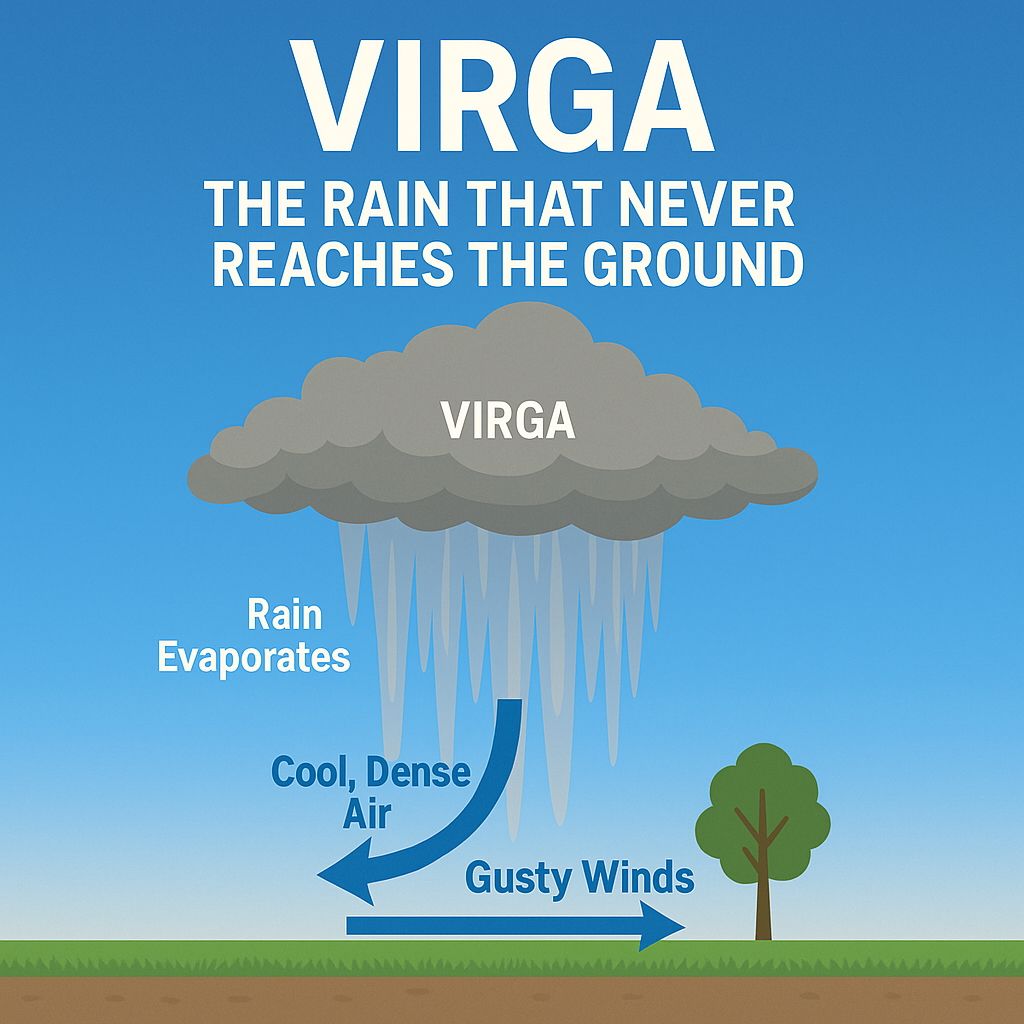A rare combination of tropical moisture, stalled thunderstorms, and rugged Hill Country terrain created the perfect setup for catastrophe. I broke down the weather ingredients that led to this deadly flash flood.
The Perfect Storm: What Caused the Deadly Flooding in Texas Hill Country
July 6, 2025
By Jay Faught
1. Remnants of Tropical Storm Barry
Late on July 3, the decaying mid-level circulation of Atlantic Tropical Storm Barry, enriched by tropical moisture, moved into Texas and merged into a broader upper‑level trough. Soon after, intense thunderstorms developed and rapidly turned into a large mesoscale convective complex, unleashing torrential rainfall across the Hill Country.
2. Exceptional Atmospheric Moisture
Multiple moisture sources fed the storm:
- Warm Gulf of Mexico waters elevated evaporative potential.
- Additional moisture streaming westward from the eastern Pacific.
- Pre-existing dry soils (due to drought) meant nearly all rainfall turned into runoff rather than soaking in
3. Stalled, Slow-Moving Thunderstorms (“Training”)
Rather than moving on quickly, the storms stalled over the same areas, dropping band after band of rain in what meteorologists call “training thunderstorms.” This happened because a stagnant upper‑level pattern left no jet-stream steering to push storms away
4. Extreme Rainfall Rates
Rain totals far exceeded forecasts: in just a few hours, 5–11 inches of rain fell over south‑central Kerr County, with radar‑indicated maxima approaching 15 inches—and in isolated pockets up to 20 inches. That translates to over 120 billion gallons of rain landing over the region nearly instantaneously.
Terrain and Hydrology: Nature’s Amplifiers
Hill Country Topography
Kerr County sits in Texas’s Hill Country, featuring steep, rocky hills, narrow valleys, and shallow limestone or granite soils that resist water absorption. When heavy rain hits, gravity rapidly funnels water into creeks and rivers with little to no infiltration—like pouring over concrete.
Fast-Rising Guadalupe River
The Guadalupe River Basin received almost all the runoff. At Hunt, gauges showed a 22‑foot rise in 2 hours, failing when it hit 29 feet. Downstream in Kerrville, levels rose 21 feet; in Comfort, the river surged nearly 29.9 feet, eclipsing historic flood levels from 1987.
The Perfect Storm
Forecast Limitations
NWS had issued Flood Watches and eventually Flash Flood Emergencies. But models typically struggle to predict extremes in locations and magnitudes for mesoscale systems like these. It’s especially hard to forecast where training bands will settle—just a few miles can turn minor to catastrophic flooding.
Timing and Awareness
The flash flood emergency came in the early pre-dawn hours, when most people—campers, tourists, residents—were asleep. Combined with limited sounding warnings in Kerr County, many were caught completely off guard.
Santa Fe Weather

Why Has It Been So Warm in Santa Fe - and Will it Last? If you’ve been enjoying the mild afternoons lately, you’re not imagining things. Santa Fe has been running unseasonably warm for much of December, with daytime highs frequently climbing well above normal and very little in the way of cold air or snow. It’s a pattern that has raised plenty of questions — especially with Christmas just around the corner. So what’s going on, and should we expect a change anytime soon? A Classic La Niña Pattern The warmth we’re experiencing is very typical of a La Niña winter, particularly early in the season. During La Niña, cooler-than-normal waters in the equatorial Pacific tend to shift the jet stream farther north. For New Mexico, that often means: Fewer storms tracking through the Southwest More frequent ridging (high pressure) over the region Warmer daytime temperatures Longer dry stretches between storms In Santa Fe, La Niña winters often start slow, especially when it comes to snowfall. Cold air struggles to push this far south, and storm systems that might normally bring snow either weaken or pass well to our north. Will This Warm Pattern Last Through Christmas? This is the question I’m hearing most right now — and based on current data, yes, the pattern looks likely to hold through Christmas and probably through the end of the year. Forecast models continue to show persistent high pressure nearby, limited storm activity, and temperatures staying above normal for late December. That doesn’t mean we can’t sneak in a brief cool-down or a weak system, but at this point it does mean there’s no clear signal for a sustained cold or snowy pattern before the calendar flips to January. In other words, if you’re hoping for a white Christmas in Santa Fe, the odds aren’t looking great this year. Mild afternoons, chilly nights, and generally dry conditions remain the most likely outcome through the holiday period. Does That Mean the Rest of Winter Is a Bust? Not necessarily — and this is where things get more interesting. While La Niña is currently influencing our weather, longer-range climate guidance continues to suggest that this event may weaken as we move deeper into winter. Several climate models are still pointing toward a transition out of La Niña and into an ENSO-neutral pattern later in the season. That matters because ENSO-neutral winters can open the door to a very different setup for New Mexico. What Happens If We Shift to ENSO Neutral? If La Niña fades and we move into neutral conditions, the jet stream often becomes more variable and less locked into one position. For Santa Fe, that can mean: More frequent storm systems reaching the Southwest Better opportunities for colder air to move south An increased chance for snow-producing systems More active weather during the second half of winter Historically, some of our better snow seasons in northern New Mexico have featured slow starts followed by a more active late winter. February and even early March can end up doing a lot of the heavy lifting when it comes to seasonal snowfall totals. The Bottom Line The recent warmth is not unusual for a La Niña winter, especially in December Current trends suggest mild and mostly dry weather through Christmas and the end of the year There are credible signs that La Niña may weaken later this winter If we transition to ENSO-neutral conditions, colder and potentially snowier weather could arrive during the second half of winter So while it may feel more like fall or spring than winter right now, winter isn’t over by a long shot (technically, it hasn't even started). Santa Fe winters have a habit of saving some surprises for later — and I’ll be watching closely to see if that late-season pattern shift begins to show up in the weeks ahead. Stay tuned.

Updated Storm Track for Weekend Storm November 14, 2025 By Jay Faught The storm system we’ve been watching all week has shifted—but this time, it’s slowing down and taking a more northerly route. That updated path dramatically changes the weekend forecast for Santa Fe and northern New Mexico. A Slower, More Northern Storm Track Earlier projections had the storm sweeping into New Mexico sooner, with a more organized band of moisture. But the latest data shows the system digging more slowly along the West Coast and pushing a bit farther north than originally expected. That shift means Southern California will now take the brunt of the storm, with periods of heavy rain and even flooding concerns in some areas. For us in Santa Fe, however, the impacts will be much more limited. Santa Fe’s Updated Forecast: Light and Late Instead of showers developing Saturday or early Sunday, the latest timing suggests isolated light rain showers won’t arrive until Sunday night. The moisture feed simply doesn’t extend far enough south to bring widespread precipitation to our area. Here’s what that means for your weekend plans: Most of the weekend stays dry—great news if you're planning outdoor activities around town or on the trails. Isolated showers Sunday night may bring brief dampness but nothing widespread or soaking. Snow Levels: Staying High There will be just enough moisture and lift Sunday night into early Monday for a few flakes in the higher terrain: Light snow is possible above 9,000 feet, mainly over the highest peaks of the Sangre de Cristo Mountains. Accumulations look minimal, and ski areas won’t see major impacts, though the first hints of winter are always exciting. Valleys, including Santa Fe, will stay warm enough for just light rain if anything at all. Bottom Line While this storm is impressive for the West Coast, its slower and more northern track means Santa Fe will see only minor impacts—mostly a few isolated showers Sunday night and perhaps a dusting of snow high in the mountains. A bigger takeaway: this pattern shift still hints at an active atmosphere as we move deeper into November. It’s a good reminder that our storm season is just getting started.









